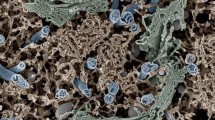Summary
The pancreatic acinar cell surfaces have been studied by SEM with a dissection technique and correlated with results obtained by TEM. The SEM results demonstrate characteristic arrangement of microplicae which in some areas are densely packed.
In many areas, the microplicae are distributed in such a manner that they create zones with typical geometrical shapes and show a relatively smooth surface.
These smooth areas may coincide, as indicated by correlated TEM results, with the limits of intimate contact between adjacent acinar cells which, in turn, represent part of the junctional complex. Another aspect revealed by these SEM preparations concerns the presence of groups of densely packed microplicae, arranged in regular rows and distributed along some grooves and/or infoldings of the cellular surface. On the basis of SEM and TEM information, it is likely that these structures correspond to intercellular (and possibly, in some cases, intracellular) canaliculi which topographically form a kind of extensive microlabyrinthine arrangement running along all the cell sides.
One final point revealed by fractured samples concerns the finding of spherical zymogen droplets within the vesicles of the Golgi complex. Because in many scanning images these vesicles appear connected by small openings, it is suggested that they may represent a system of intercommunicating chambers (vacuoles) through which the zymogen droplets can be continuously accumulated and discharged into the acinar lumen.
Similar content being viewed by others
References
Anderson, T.F.: Techniques for the preservation of three-dimensional structure in preparing specimens for the electron microscope. Trans. N.Y. Acad. Sci. 13, 130–134 (1951)
Andrews, P.M.: Microplicae: Characteristic ridge-like folds of the plasmalemma. J. Cell Biol. 68, 420–429 (1976)
Andrews, P.M., Porter, K.R.: A scanning electron microscopic study of the nephron. Amer. J. Anat. 140, 81–116 (1974)
Bogart, B.I.: Secretory dynamics of the rat submandibular gland. An ultrastructural and cytochemical study of the isoproterenol-induced secretory cycle. J. Ultrastruct. Res. 52, 139–155 (1975)
Fujita, T.: A scanning electron microscope study of the human spleen. Arch. histol. Jap. 37, 187–216 (1974)
Grisham, J.W., Nopanitaya, W., Compagno, J., Nagel, A.E.H.: Scanning electron microscopy of normal rat liver: The surface structure of its cells and tissue components. Amer. J. Anat. 144, 295–322 (1975)
Ichikawa, A.: Fine structural changes in response to hormonal stimulation of the perfused canine pancreas. J. Cell Biol. 24, 369–382 (1965)
Leeson, C.R.: The fine structure of the parotid gland of the spider monkey (Ateles paniscus). Acta anat. (Basel) 72, 133–147 (1969)
Luft, J.A.: Improvements in epoxy resin embedding methods. J. biophys. biochem. Cytol. 9, 409–414 (1961)
Miller, M.M., Revel, J.P.: Scanning electron microscopy of epithelia prepared by blunt dissection. Anat. Rec. 183, 339–357 (1975)
Motta, P., Andrews, P.M., Porter, K.R.: Microanatomy of cell and tissue surfaces. An atlas of scanning electron microscopy (G.F. Vallardi and Lea Febiger, eds.). Milano-Philadelphia: 1976
Motta, P., Fumagalli, G.: Structure of rat bile canaliculi as revealed by scanning electron microscopy. Anat. Rec. 182, 499–513 (1975)
Motta, P., Porter, K.R.: Structure of rat liver sinusoids and associated tissue spaces as revealed by scanning electron microscopy. Cell Tiss. Res. 148, 111–125 (1974)
Motta, P., Van Blerkom, J.: A scanning electron microscopic study of the luteo-follicular complex. II. Ovulation. Amer. J. Anat. 143, 241–264 (1975)
Porter, K.R., Kelley, D., Andrews, P.M.: The preparation of cultured cells and soft tissues for scanning electron microscopy. In: Proceedings of the Fifth Annual Stereoscan Electron Microscope Colloquium. Kent Cambridge Scientific, Inc., Grove, 111., pp. 1–20, 1972
Revel, J.P.: Scanning electron microscope studies of cell surface morphology and labeling “in situ” and “in vitro”. In: Scanning electron microscopy (O. Johari and I. Corvin, eds.). IIT Res. Inst., Chicago, pp. 542–548 (1974)
Reynolds, E.S.: The use of lead citrate at high pH as an electron-opaque stain in electron microscopy. J. Cell Biol. 17, 208–212 (1963)
Sabatini, D.D., Bensch, K.G., Barrnett, R.J.: Cytochemistry and electron microscopy. The preservation of cellular ultrastructure and enzymatic activity by aldehyde fixation. J. Cell Biol. 17, 19–58 (1963)
Tanaka, K., Iino, A., Naguro, T.: Scanning electron microscopic observation of intracellular structures. In: Proceedings of the 10th Int. Congr. Anat. Tokyo (E. Yamada, ed.), Science Council of Japan, p. 366 (1975)
Tandler, B.: Ultrastructure of the human submaxillary gland. I. Architecture and histological relationships of the secretory cells. Amer. J. Anat. 111, 287–307 (1962)
Tokunaga, J., Edanaga, M., Fujita, T., Adachi, K.: Freeze cracking of scanning electron microscope specimens. A study of the kidney and spleen. Arch. histol. Jap. 37, 165–182 (1974)
Vial, J., Porter, K.R.: Scanning microscopy of dissociated tissue cells. J. Cell Biol. 67, 345–360 (1975)
Watson, M.L.: Staining of tissue sections for electron microscopy with heavy metals. J. biophys. biochem. Cytol. 4, 175–177 (1958)
Author information
Authors and Affiliations
Rights and permissions
About this article
Cite this article
Motta, P., Andrews, P.M., Caramia, F. et al. Scanning electron microscopy of dissociated pancreatic acinar cell surfaces. Cell Tissue Res. 176, 493–504 (1977). https://doi.org/10.1007/BF00231404
Accepted:
Issue Date:
DOI: https://doi.org/10.1007/BF00231404



